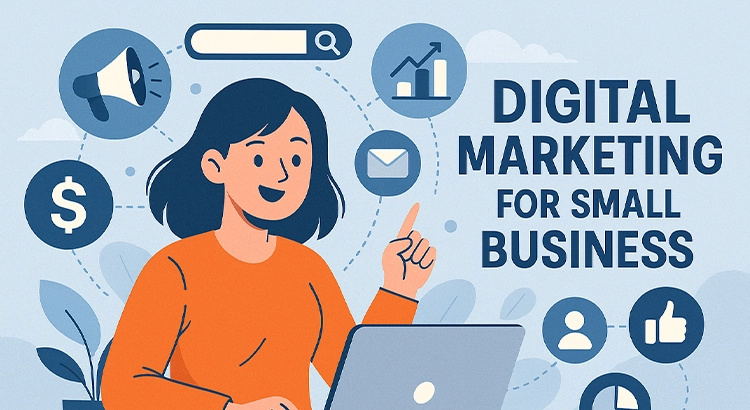Digital marketing for small business owners is more important than ever in today’s online-driven world. The best digital marketing companies understand how to help local enterprises expand their reach with effective tactics. This article explores practical, result-oriented methods tailored for entrepreneurs.
Benefits of Digital Marketing for Small Business
A strong online presence offers more than visibility—it creates lasting impressions, builds relationships, and opens new revenue opportunities for growing ventures. Below are key advantages explained clearly and concisely.
1. Increased Visibility Online
Being active on digital platforms allows your company to be found by more people, especially those searching for your services. Whether through search engines or social channels, your business stays top-of-mind.
2. Cost-Effective Outreach
Compared to traditional advertising, online marketing offers measurable, budget-friendly ways to connect with potential buyers through tools like email, content, or targeted advertising.
3. Better Audience Targeting
You can narrow down your audience based on specific demographics, behavior, and interests, helping your campaigns become more effective and relevant.
4. Measurable Results
Modern analytics tools let you track every click and conversion, offering clear insight into which tactics are bringing in real outcomes.
5. Higher Engagement Rates
Posting regular updates, videos, or guides helps you connect with customers, keeping them engaged and building trust in your services.
6. Stronger Brand Identity
Visuals, messaging tone, and content style across online channels help build a recognizable image that sticks with your audience.
7. Competitive Edge
With smart tactics, even newer or smaller companies can compete with bigger names by highlighting their unique value in the online space.
Small Business Online Marketing Tips
When building your online approach, it’s important to focus on authenticity, visibility, and value. Here are proven techniques that help independent brands thrive.
1. Brand Yourself
Your promotional methods should always reflect your company’s unique identity. From the fonts you use to your color palette and tone of voice, these elements all influence how people perceive you. Whether you’re aiming for a sleek and high-end look or something casual and approachable, consistency is key. A memorable brand helps people recall your business long after they’ve visited your website.
2. Define Your Target Audience
Before diving into any promotional effort, it’s crucial to know exactly who you’re trying to reach. Think about your ideal customer’s age, profession, income level, interests, and habits. Use this information to build detailed buyer personas. These profiles help you tailor your content, ads, and overall messaging to attract the right people.
3. Use Google Business Profile
An updated Google Business Profile can make a big difference in local visibility. When people search for services in your area, your profile can appear in Google’s local results. It showcases your contact information, hours, and reviews. This simple step ensures potential customers can easily find and contact you.
4. Optimize Your Presence in Search Results
SEO is a powerful way to improve visibility. By researching the right keywords, improving site speed, and ensuring your pages are mobile-friendly, you can increase your chances of appearing in search results. Focus on long-tail keywords and continue adding fresh, relevant content to your site.
5. Start a Blog
Adding a blog to your site gives you a space to share knowledge and attract visitors organically. Write posts that address questions your audience might be asking. For instance, a pest control company could publish articles about seasonal bugs, while a local bookstore could review new releases. The goal is to become a go-to resource in your niche.
6. Launch Paid Search Campaigns in Google Ads
With a modest budget, you can still compete for attention using paid search ads. These appear at the top of Google results and let you target specific keywords and demographics. Even if someone doesn’t buy right away, your ad puts your brand on their radar, helping build awareness over time.
7. Build Some Email Remarketing Lists
Remarketing is all about staying in touch with those who’ve already interacted with your site. You can collect email addresses through simple signup forms by offering something in return—like a discount or newsletter. Then, keep your business top-of-mind with engaging follow-up emails.
8. Make Your Site Mobile-Friendly
Fast-loading, mobile-friendly websites keep users engaged. To make sure visitors stick around, reduce image sizes, cut down on redirects, and cache your content. This improves the experience for people browsing on phones or tablets and can even boost your search rankings.
9. Create a Social Media Account
Social media is where people spend a lot of their time online. Create an account and start posting valuable content like videos, tips, or behind-the-scenes glimpses. You can also run paid promotions to put your message in front of a wider audience and drive traffic to your site.
10. Produce Video Content
Video can explain your products, showcase your team, or tell your brand’s story. You can host these clips on your website, post them on social platforms, or start a channel to reach a broader audience. It’s a flexible format that’s highly engaging and easy to share.
11. Track Your Campaigns to See Where You Can Improve
No matter which promotional tactics you use, measuring results is vital. Pay attention to metrics like clicks, conversions, traffic sources, and time on site. These insights show what’s working and where you might need to tweak your approach.
Summary
Online marketing offers limitless potential for small businesses aiming to expand their presence and grow their customer base. Whether through SEO, social content, or paid ads, each approach plays a part in building trust and driving results. The key is to stay consistent, track your efforts, and always center your approach around your target audience.


